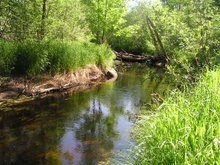 I got help from frequent commenter Hap in New Hope on this little bird's id. I saw this young bird two weeks ago at Hasty Brook. Hap said it looks to be an immature mourning warbler. Another opinion from a local birder confirmed it. I wonder if I'll ever be skilled enough to id young or fall plumage warblers.
I got help from frequent commenter Hap in New Hope on this little bird's id. I saw this young bird two weeks ago at Hasty Brook. Hap said it looks to be an immature mourning warbler. Another opinion from a local birder confirmed it. I wonder if I'll ever be skilled enough to id young or fall plumage warblers. Fuzzy, but a different view.
Fuzzy, but a different view.Even putting aside the confusion of non-breeding plumages, I'm not sure that I can always tell that a bird is a young one. Does anyone have any general tips for aging birds?





15 comments:
Oh heck, I'd be flummoxed too Lynne. Now show me a wound on a leg and I'm your girl! :c)
No, but I just wanted to say "hi!"
These are my (admittedly non-expert) tips for telling young birds.
1) Recently fledged birds usually still have some yellow at the gape (the "outer corners of the mouth.") If it isn't yellow, the gape still makes it look like they have a big mouth. (Think Carol Channing.)
2) Young birds often act "babyish" - they follow their parent around, quivering their wings and begging for food. If I see one bird following another one closely (and it isn't breeding season) I suspect it is a recently fledged youngster.
3) Young birds are noisy. I picked up a recently fledged Eastern Meadowlark last week when two birds flew up and landed on the power line in front of my house and one left immediately. The second bird sat there, vocalizing, till I finally grabbed my bins and confirmed it by seeing ...
4) Young birds are "messy." They have terminal "bad hair day." In the case of the meadowlark, its plumage was rough-looking, fuzzy and frizzy, not sleek like an adult, and the black markings had irregular edges, not crisp and clean. Sometimes, this puffy look makes it appear that ...
5) Young birds are bigger than the parent bird they are hanging out with. They aren't bigger, really, but they look that way.
These tricks only work for recent fledged young. Once they are on their own and wearing the appropriate feather pattern, it is matter of knowing who molts to an adult plumage right away (chickadees, for example), who has some juvenile markings (the spotted breasts of young robins and bluebirds) and who has a completely different juvenile plumage (purple martins have a Hatch Year, a Second Year, and an After Second Year or adult, plumage.) Some gulls take 4 years to get adult feathering.
Does that help?
~Kathi, who still is stymied by fall warblers
Nice to see a new bird for me.
Pretty little bird but, of course, me being such a novice I can't help with the ID. Someday I'm hoping I'll have enough knowledge to ID birds. You are so lucky with the variety of birds you get there at Hasty Brook.
Me being more a photographer than a birder, I just say it is a nice photograph of a bird I have never seen. Thanks for sharing. Naturally I like the top photo better, but you said that yourself.
Oh, and I forgot to say. Hap is the reason I opened up my comments even if anonymous. I do like that Hap does leave his name with his anonymous comments.
Lynne your doing so well with your bird ID's! I'm not good with warblers or shorebirds!! I really need to get a good picture for most and then look them up. I only have two warblers that nest here, yellow and common yellowthroat, but hey they are sweet too!! Love the Fixer upper!! Wish I had one!
Thanks!
I'm pretty good with ID ing but when it comes to these flitty little hard to see and photograph 'warblers' I can't do it. The problem is they have 'spring plumage' breeding plumage' and fall and migration plumage' Now that's a heap of knowledge to learn and carry around. Just post them and let someone ID them for you! haha!! great little bird by the way!
Cool tips from Katdoc.-I would have a tough time also Lynne.-Birdforum.net under the bird indetification section is a good spot to post photos and get an opinion.-That does not mean that all of them are right but if you wait long enough, you can usually tell by the amount of supporting evidence someone provides.-Nice find by the way!
Dear Lynne,
I would have no idea but I am so excited to read all your comments. Katdoc has lots of great tips.
I shall keep checking in and I will be taking notes!
Sherry
Dear Lynne,
I would have no idea but I am so excited to read all your comments. Katdoc has lots of great tips.
I shall keep checking in and I will be taking notes!
Sherry
Advice for iding birds?
--have a helper like Hap!
Beautiful shots, but I'm only here in comments to see if I can pick up hints too :-) Those immature birds baffle me.
Hap, from New Hope, is a very helpful reader to many blogs it seems.
Post a Comment